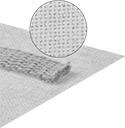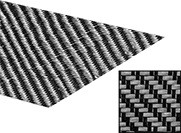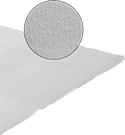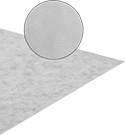About Composites
More
About Hook and Loop
More
Aramid/Fiberglass Blend Fabric

A blend of aramid and fiberglass, this fabric resists mildew and abrasion. It is self-extinguishing and won't melt, so it's often used for insulation applications.
| Wd. | Thick. | Density, oz./sq. yd. | Max. Temperature, °F | Color | Lengths, ft. | Per Ft. | |
| 1/2" | 1/16" | 19 | 600° | Yellow | 0000000 | 00000 | |
| 1/2" | 1/8" | 40 | 600° | Yellow | 0000000 | 0000 | |
| 1" | 1/16" | 19 | 600° | Yellow | 0000000 | 0000 | |
| 1" | 1/8" | 40 | 600° | Yellow | 0000000 | 0000 | |
| 2" | 1/16" | 19 | 600° | Yellow | 0000000 | 0000 | |
| 2" | 1/8" | 40 | 600° | Yellow | 0000000 | 0000 | |
| 3" | 1/16" | 19 | 600° | Yellow | 0000000 | 0000 | |
| 3" | 1/8" | 40 | 600° | Yellow | 0000000 | 0000 | |
| 40" | 0.030" | 8 | 600° | Yellow | 000000 | 00000 | |
| 40" | 0.057" | 17 | 600° | Yellow | 000000 | 00000 | |
| 40" | 0.110" | 30 | 600° | Yellow | 000000 | 00000 |
Composite Fabrics

Use these resin-free fabrics to reinforce or repair existing composites as well as create new composites. Mold custom-shaped composite parts by layering your choice of fabric with an epoxy. The epoxy (sold separately) is a two-part resin that begins to harden in 15 hours and reaches full strength in 4 days. Finished composite pieces withstand temperatures up to 250° or 350° F.
Fabrics with a plain, twill, or triaxial weave have fibers that are woven in alternating directions for uniform strength and rigidity in all directions. Easier to machine than fabrics with a unidirectional weave, their woven pattern holds the fibers together to limit splintering. Twill-weave fabrics are stronger than plain-weave fabrics. They’re also more flexible, making them easier to manipulate into complex shapes. They will not, however, retain their shape as well as plain-weave fabrics.
Kevlar fabrics are a super-tough material that offers excellent wear and abrasion resistance.
Cut-Resistant Kevlar Webbing

This webbing resists abrasion caused by sharp corners and edges. Use it to create straps, belts, and tie downs. It has a finished end with a locking stitch that won't unravel. To prevent fraying after a new cut, fold and sew or use a finishing tip.
Note: Breaking strength is the force at which new webbing will break, and should never be considered the work load limit.
Warning: Never use for lifting applications.
Heat-Resistant Nomex Webbing

Often used in temperatures up to 500° F without burning or melting. This webbing is also soft to the touch. Use it to create straps, belts, and tie downs. It has a finished end with a locking stitch that won't unravel. To prevent fraying after a new cut, fold and sew or use a finishing tip.
Note: Breaking strength is the force at which new webbing will break, and should never be considered the work load limit.
Warning: Never use for lifting applications.
Stainless Steel Hook and Loop

Woven from flexible stainless steel yarn, this hook and loop withstands temperatures up to 800° F. Weld, sew, or glue it to a surface. Strength will diminish with repeated use.





























